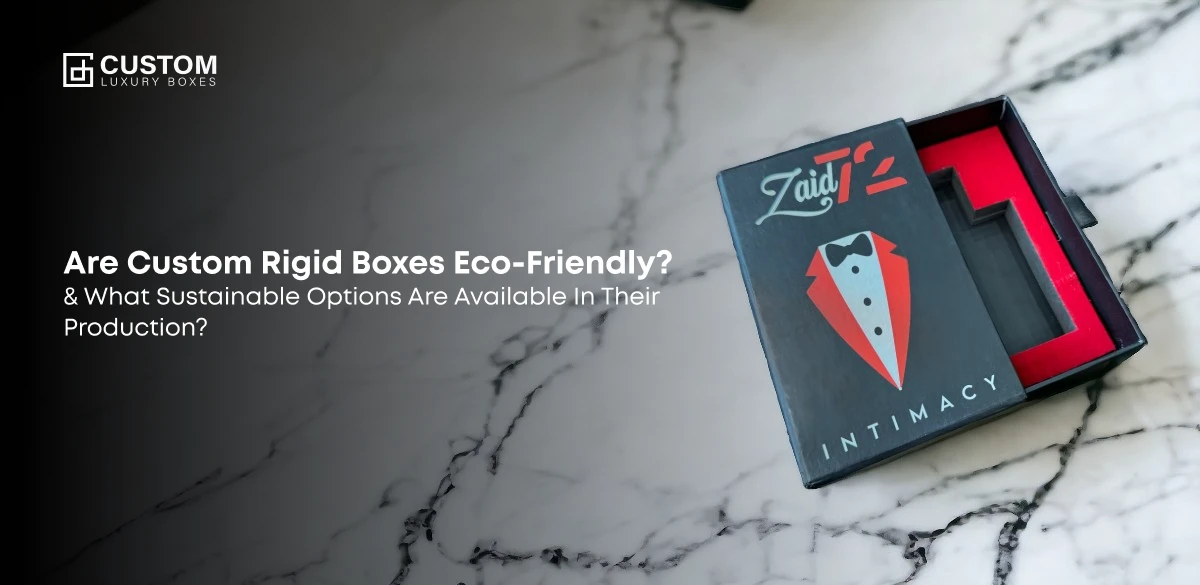In a time when environmental consciousness is high, the packaging sector is under more and more pressure to ensure that its goods are environmentally friendly. Custom personalized luxury rigid boxes made upon request, are renowned for their strength and aesthetic appeal. This piece investigates the environmental effect of personalized rigid boxes and looks at workable substitutes.
Understanding the Environmental Impact of Custom Rigid Boxes
Custom luxury rigid packaging boxes, commonly crafted from materials like paperboard or chipboard, offer superior protection and presentation for products. However, their production processes and material sourcing can pose significant environmental challenges.
- Material Sourcing and Deforestation
- Virgin fibers used in traditional rigid box production contribute to deforestation and habitat destruction.
- Unsustainable logging practices further exacerbate environmental concerns associated with material sourcing.
- Manufacturing Processes
- Chemical treatments and energy-intensive processes are often involved in the production of custom rigid boxes.
- These processes contribute to pollution and greenhouse gas emissions, exacerbating climate change.
Exploring Sustainable Solutions for Custom Luxury Rigid Boxes
Despite the environmental challenges, the packaging industry is making strides toward sustainability through innovative approaches and alternative materials.
- Utilization of Recycled Materials
- Incorporating post-consumer waste into box production reduces the demand for virgin fibers and diverts waste from landfills.
- Recycled content significantly reduces the carbon footprint of rigid boxes, promoting a circular economy.
- Adoption of Alternative Materials
- Exploration of plant-based and biodegradable plastics offers comparable strength and durability to traditional paperboard.
- These materials are compostable or recyclable, minimizing environmental harm at the end of their lifecycle.
- Implementation of Eco-Friendly Manufacturing Processes
- Investment in renewable energy sources, such as solar and wind power, reduces reliance on fossil fuels and decreases greenhouse gas emissions.
- Optimizing production methods to minimize waste generation and water usage contributes to a more sustainable supply chain.
Optimizing Design for Sustainability
Design optimization is crucial in enhancing the eco-friendliness of custom rigid boxes, offering efficiency and environmental benefits.
- Dimensional Optimization
- Optimizing packaging dimensions reduces material usage and minimizes waste, lowering environmental impact.
- Efficient packaging dimensions also contribute to reduced shipping costs and carbon emissions.
- Innovative Design Solutions
- Modular packaging and collapsible structures offer versatility and efficiency while reducing environmental impact.
- Innovative designs promote reusability and resource efficiency throughout the packaging lifecycle.
Collaboration for Sustainable Packaging Practices
Collaboration throughout the supply chain is essential for promoting sustainability in packaging practices.
- Partnerships with Sustainable Suppliers
- Brands can partner with suppliers and manufacturers committed to environmental stewardship, ensuring transparency and accountability in the production process.
- Consumer Education Initiatives
- Educating consumers about the importance of sustainable packaging choices empowers individuals to make informed purchasing decisions.
- Awareness campaigns raise consumer consciousness and drive demand for eco-friendly packaging solutions.
Conclusion
Custom rigid boxes can be reduced in environmental impact by using recycled materials, using substitute substrates, implementing sustainable production procedures, and improving design tactics. Future sustainable packaging solutions will be developed through innovation and teamwork, satisfying customer preferences while reducing packaging’s ecological footprint.

